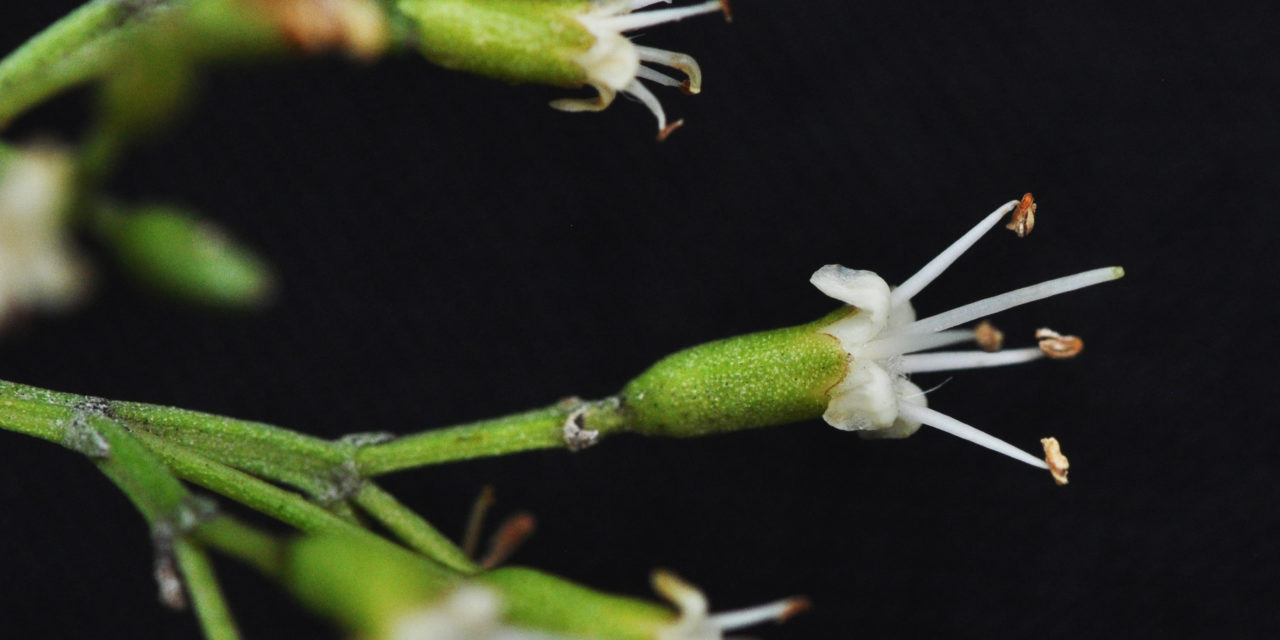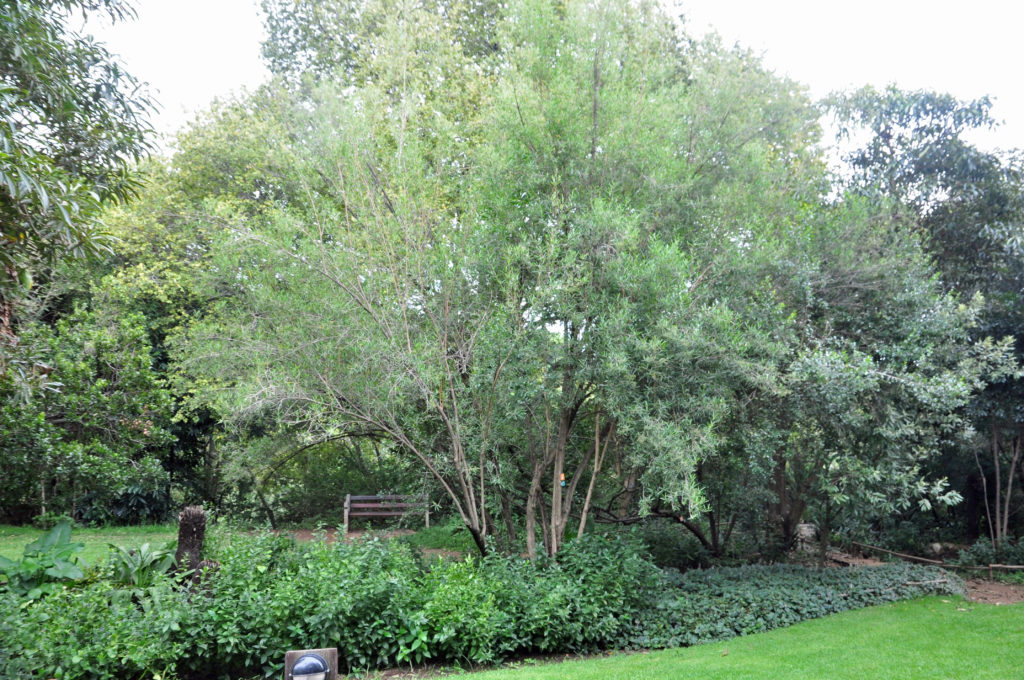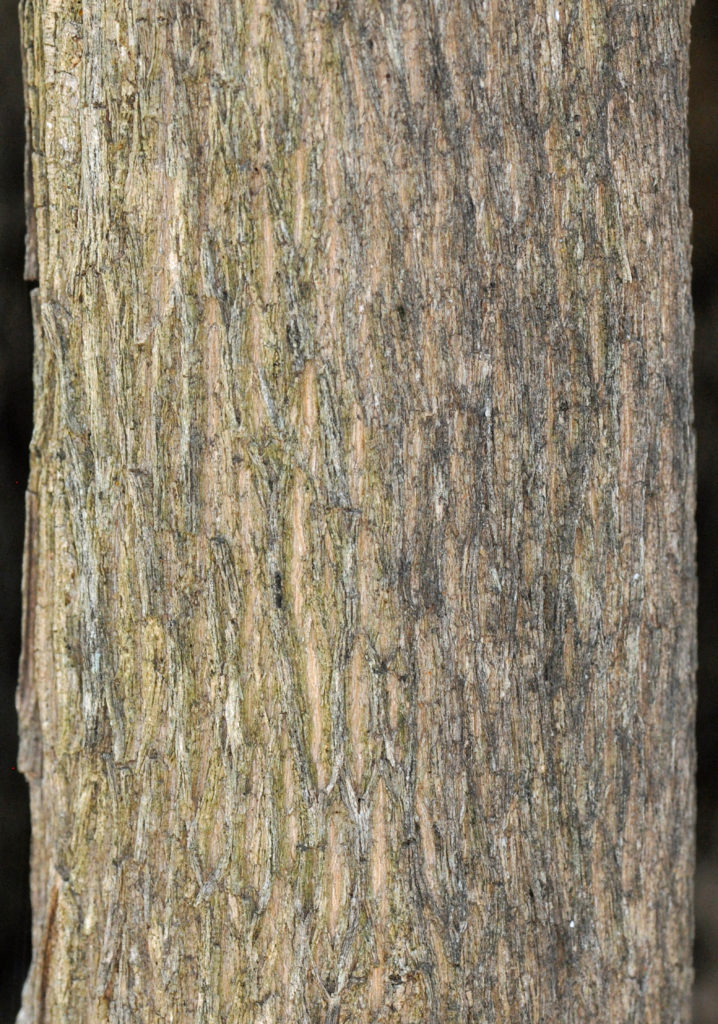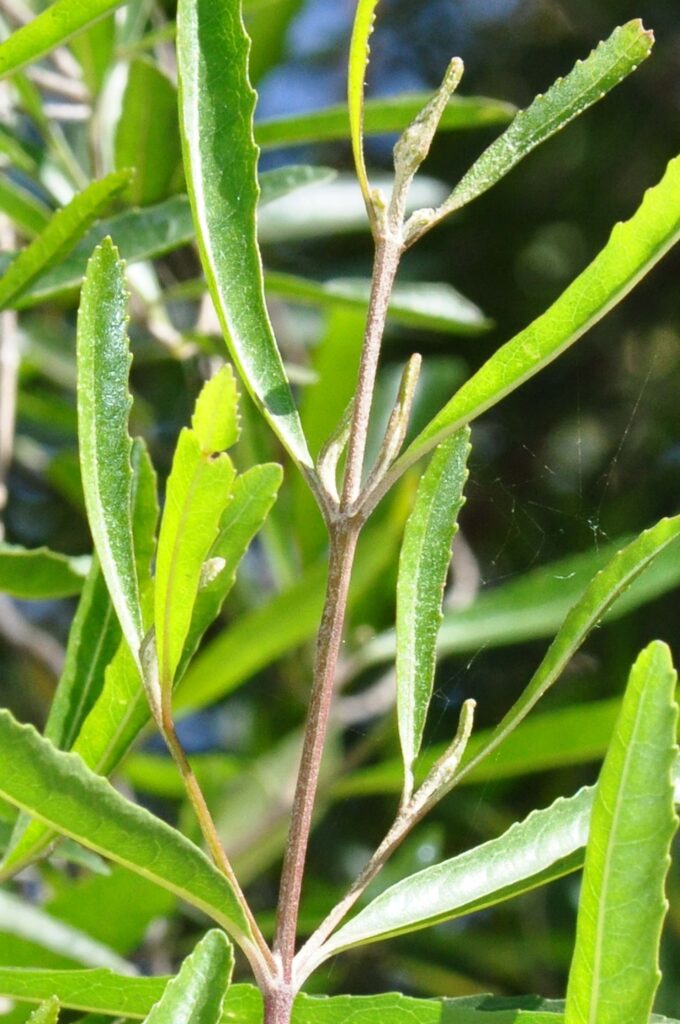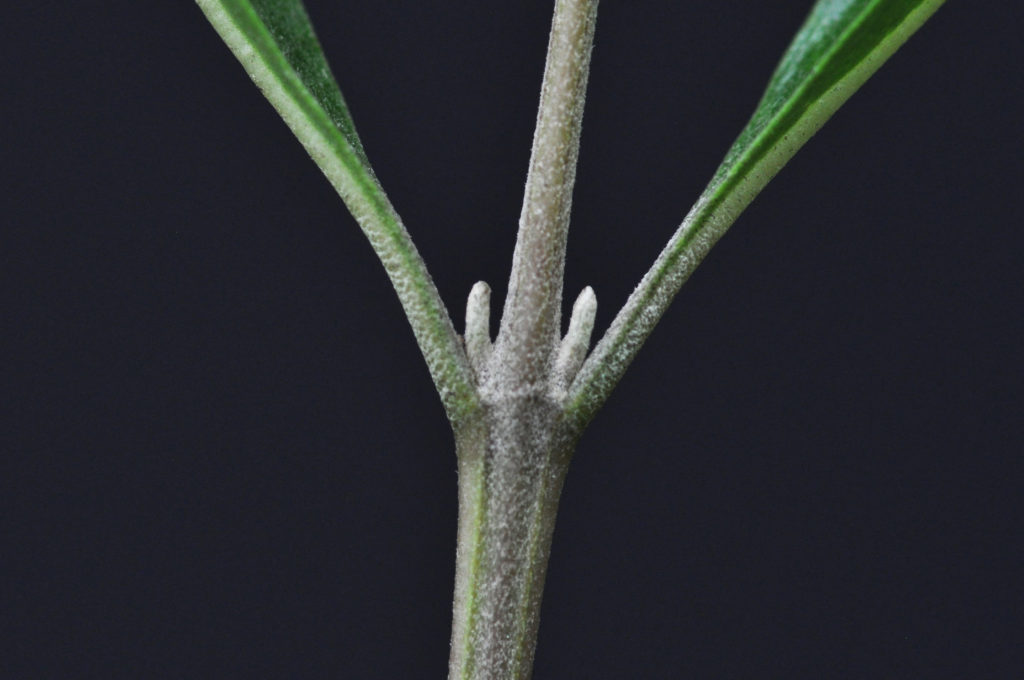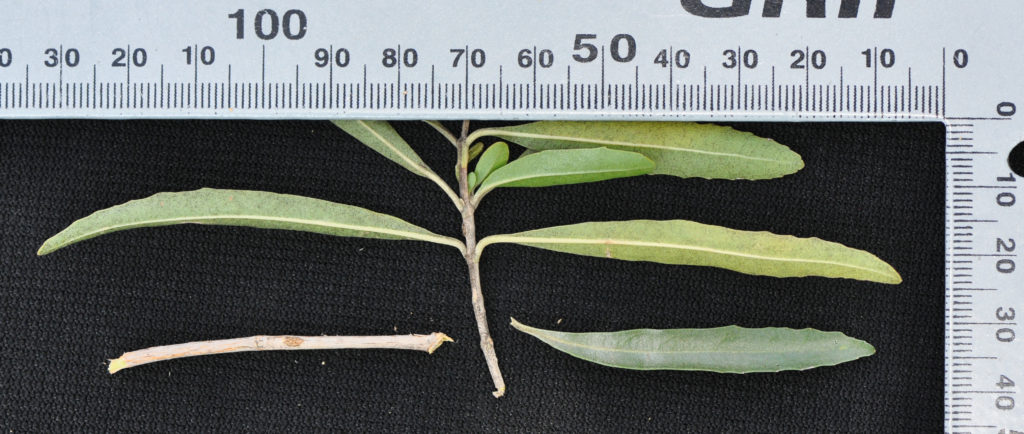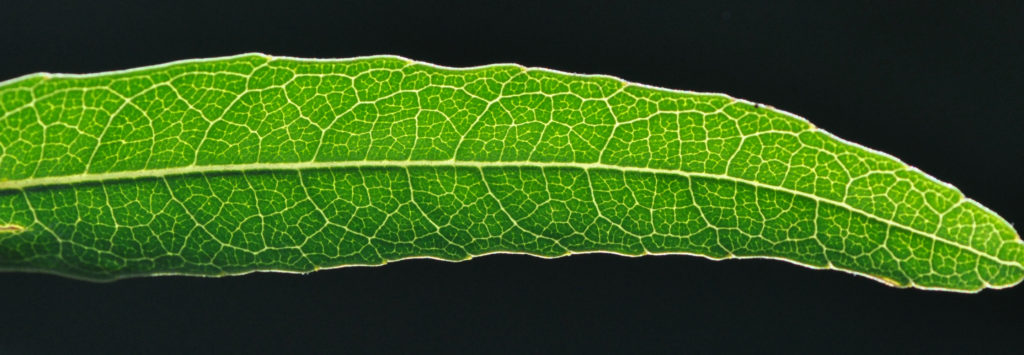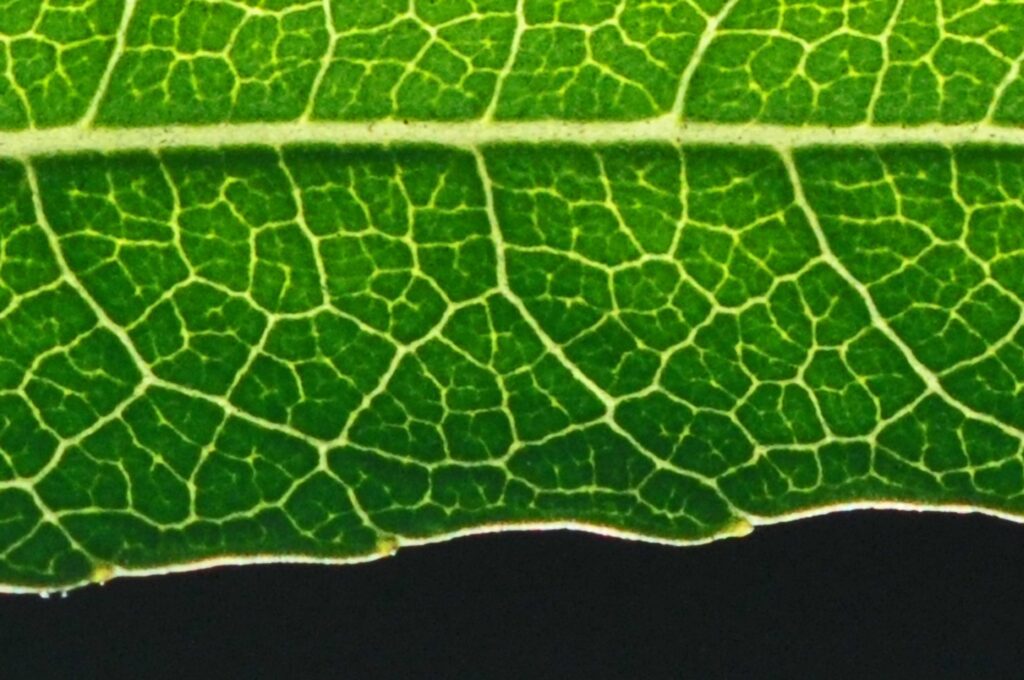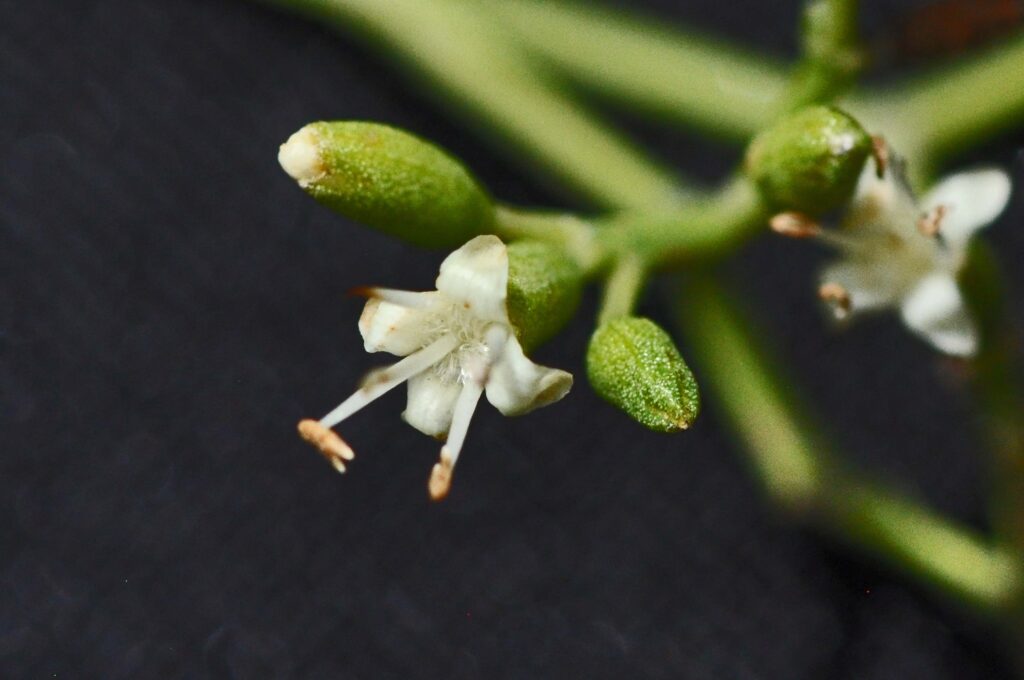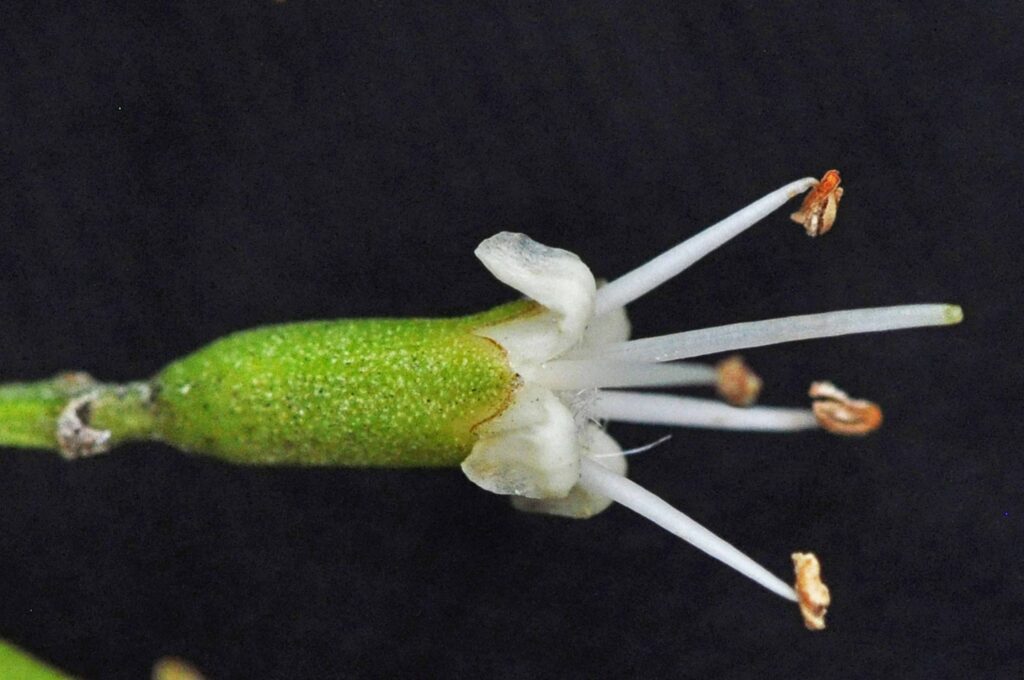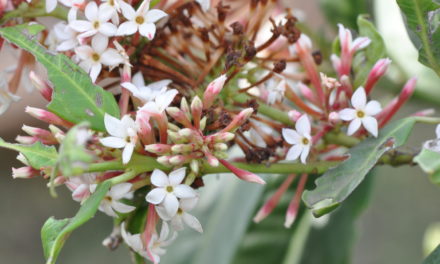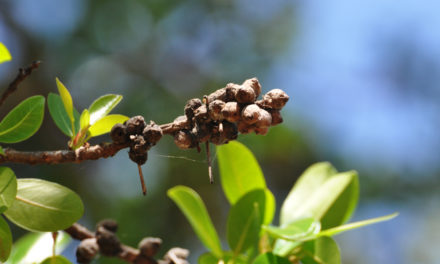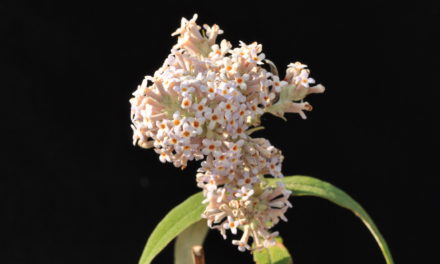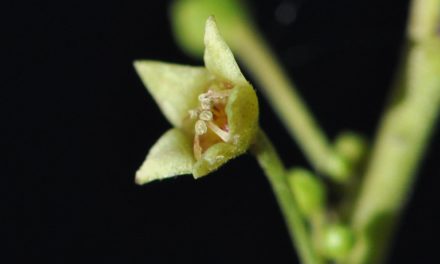General Info – summary
This deciduous, spineless, slender Tree is up to 8m high & may be a multi-stemmed shrub. Bark may become gnarled with long fissures. Simple, light green, linear Leaves are opposite with thin interpetiolar stipules. Margins may be shallowly toothed. Tiny 4-merous, bisexual, white Flowers are regular & each develop 4 extended stamens and one stigma. Fruit: a small brown capsule + persistent calyx & tiny seeds.
Description
Nuxia oppositifolia
Previous Names: Lachnopylis oppositifolia, Nuxia dentta, Nuxia schlechteri.
SA Tree No. 635.
Common names: (Afr) Watervlier. (Eng) Bushvel Nuxia, Water Elder, Water Nuxia. (isiXhosa) Ingqota, Isikali. (isiZulu) Umhlambandlazi, Inkhweza, Inkweza, Ithambo, Umkhobeza. (siSwati) Sikhweza, Sitsambo, Inkunzi. (Tshivenda) Mulamvuvhu.
Family: Stilbaceae: (Family with 6 genera and about 14 species). Local genera on this website include Anastrabe, Bowkeria, Halleria, and Nuxia. Members of this family have simple and entire Leaves that lack stipules and have recurved margins. Non-stellate hairs are present. Flowers are bisexual and zygomorphic or regular and the corolla is funnel-shaped and usually 2-lipped. The usually 4 Stamens are epipetalous, and the usually superior Ovary initially has 2 locules each with 1 ovule. Fruit is usually a dehiscent capsule but may be a berry.
Name derivation: Nuxia – named after M. de la Nux – a French botanist on Reunion Island. oppositifolia – with opposite leaves. There are 5 species of the genus Nuxia in the southern Africa.
Conservation Status: L C. (Least Concern). Assessment: 2005 (W. Foden and L. Potter).
Tree
This multi-stemmed shrub or slender willow-like Tree (photo 04) may reach 8m high and the trunk is usually narrow. The smooth or slightly rough, stringy and longitudinally fluted (marked by grooves) Bark (photo 755) peels off in thin strips. The bark is grey to reddish brown and gnarled (knobbly, rough, and twisted, especially with age). The Branches are long, thin, drooping and willow-like. Branchlets (a small branch or division of a branch – especially a terminal division; usually applied to branches of the current or preceding year) may be slightly angular to squarish (photo 762) and hairy. Thorns and spines are absent.
- 04. 2018/03/07. Walter Sisulu NBG. Photo: David Becking.
- 755. 2016/08/30. Walter Sisulu NBG. Photo: David Becking.
- 762. 2016/08/30. Walter Sisulu NBG. Photo: David Becking.
Leaves
The Leaves on this deciduous plant are simple (has a single blade, which may have incisions that are not deep enough to divide the blade into leaflets). Leaves are usually opposite – a distinguishing feature for this species (photos 762, 02 & 753) and usually not 3-whorled. Only the young leaves are slightly sticky and finely hairy. The thinly textured Blade may be glossy, greyish green above and lighter below (photo 753). Leaves are light to greyish green above and even lighter below. Each linear to narrowly oblanceolate leaf is up to 9 x 1,5cm (often less – photo 753), and more than 4 times longer than wide. The broadly tapering Apex has a blunt or round ending. The Base narrows and the blade is decurrent (leaf blades that partly wrap or have wings around the stem or Petiole – leaf stalk – photo 02). Lateral and other Veins are not conspicuous. They become more visible when examined with a hand lens – when viewing the leaf against a strong light. Here, just beyond each small bump, a vein connects with the margin (photo 795). In the next photo (795 enlarged), these links appear to be glandular. The Margins may be wavy, shallowly toothed or lobed especially towards the apex. They may also be entire (with a continuous margin, not in any way indented). The raised Midrib is visible below (photo 753). The Petiole is up to 1,2cm long. The reduced Stipules (basal appendages of the petiole) are interpetiolar, occurring as a line between adjacent petioles (photo 02).
- 02. 2018/03/07. Walter Sisulu NBG. Photo: David Becking.
- 753. 2016/08/30. Walter Sisulu NBG. Photo: David Becking.
- 795 2017.11.07 Walter Sisulu NBG. Photo: David Becking. Leaf against the sun.
- 795 Enlarged. 2017/11/07. Walter Sisulu NBG. Photo: David Becking.
Flowers
The very small, inconspicuous Flowers appear during spring and continue to the end of summer. The white flowers appear far more attractive when observed through a hand lens. Flowers are located in dense clusters of 3 (photo 305) towards the ends of branches. The tubular flowers are bisexual and actinomorphic (Regular, symmetrical. Flowers are vertically divisible into similar halves by more than 1 plane passing through the axis). The shiny green Calyx has 4 Sepals with lobes which are leathery, erect (photo 508) and lined with internal hairs. The Corolla has 4 white Petals that have a hairy throat (photo 305 & 508). After emerging from the calyx, the petals lobes curl downwards. There are 4 clearly visible Stamens that extend beyond the petals (photo 508). The straight white Filaments are almost as long as the rest of the flower and they protrude from the flower at up to 50 degrees from the vertical. The Anthers have 2 theca (pollen sacs) that are V-shaped (photo 305). There is a single Pistil (a unit of the Gynoecium, the female element of the flower, composed of the Ovary, Style and Stigma). The superior Ovary is composed of 2 fused Carpels (organs at the centre of a flower, bearing many ovules). The Ovary narrows into the Style which extends the white Stigma above the corolla tube and slightly beyond the anthers (photo 508). (Oct-May).
- 305. 2018/01/11. Walter Sisulu NBG. Photo: David Becking.
- 508. 2018/01/24. Walter Sisulu NBG. Photo: David Becking.
Fruit
The small, about 5mm long, Fruit is an oblong, hairy Capsule (a dry fruit resulting from the maturing of a compound ovary with more than 1 carpel). This capsule splits into 2 valves that split at the apex. It is dark brown when mature and is almost enclosed by the remains of the persistent Calyx. Many small Seeds are produced, and old capsules remain on the tree for some time. (Jan-May).
Distribution & Ecology
These Trees are common in the Lowveld (land areas that lie at an elevation of between 150 and 600 metres) and occur in parts of KwaZulu-Natal and Mpumalanga e.g., Kruger NP, Limpopo e.g., near Groblersdal as well as Eswatini (Swaziland) and southern Zimbabwe. Trees also occur in Madagascar, northern Namibia and northwards to include Ethiopia and Arabia. Generally, they occur among the rocks and reeds, close to rivers, streams and in sandy valleys in the lowveld. They are often in thickets (a dense group of bushes or trees – often with only one or a few species). The altitude range of these plants is up to 2 500m and they often grow together with the White Pear (Apodytes dimidiate). Black Rhino eats both the Bark and the Leaves. Other game also browse the leaves. The Flowers attract insects, which in turn, attract birds.
Ethnobotany
The Wood is reddish-yellow to pale brown, reasonably dense (having a high mass per unit volume), close grained but not very sturdy. It is occasionally used to make furniture and small ornaments. This tree is best propagated from hormone treated cuttings.
References
Boon, R. 2010. Pooley’s Trees of eastern South Africa. Flora and Fauna Publications Trust, Durban.
Burrows, J.E., Burrows, S.M., Lotter, M.C. & Schmidt, E. 2018. Trees and Shrubs Mozambique. Publishing Print Matters (Pty) Ltd. Noordhoek, Cape Town.
Coates Palgrave, M. 2002. Keith Coates Palgrave Trees of Southern Africa, edn 3. Struik, Cape Town.
Foden, W. & Potter, L. 2005. Nuxia oppositifolia (Hochst.) Benth. National Assessment: Red List of South African Plants version 2020.1. Accessed on 2023/09/17.
Lawrence, G. H. M, 1951. Taxonomy of Vascular Plants. The Macmillan Company, New York. Tenth Printing 1965.
Palmer, E. & Pitman, N. 1972. Trees of southern Afric., Balkema, Amsterdam, Cape Town.
Schmidt, S. Lotter, M. & McCleland, W. 2002. Trees and Shrubs of Mpumalanga and the Kruger National Park. Jacana, Johannesburg.
van Wyk, B. & van Wyk, P. 1997 Field guide to Trees of Southern Africa. Struik, Cape Town.
http://www.zambiaflora.com/speciesdata/species.php?species_id=144490
http://www.plantzafrica.com/plantnop/nuxiaopposit.htm
http://posa.sanbi.org/flora/browse.php?src=SP
http://www.theplantlist.org/1.1/browse/A/Stilbaceae/

